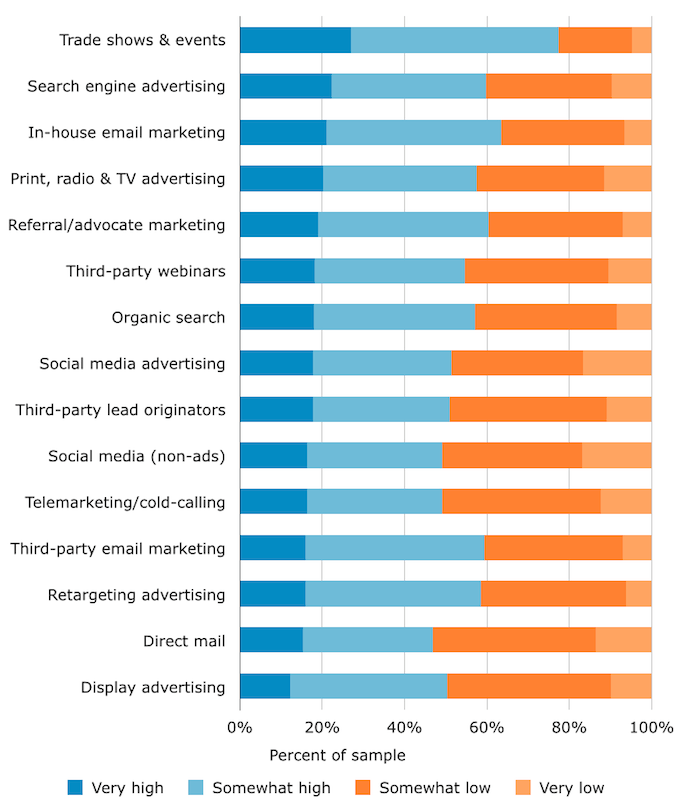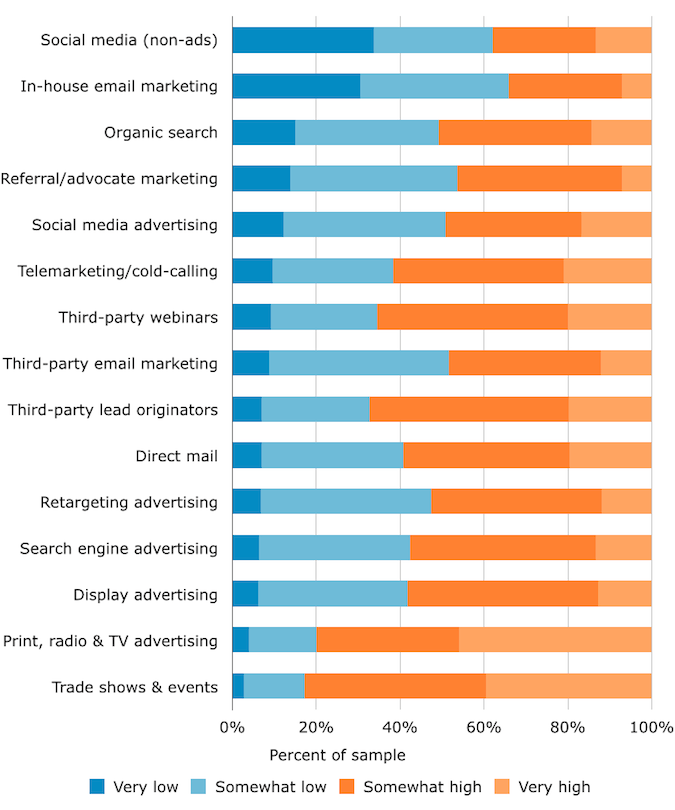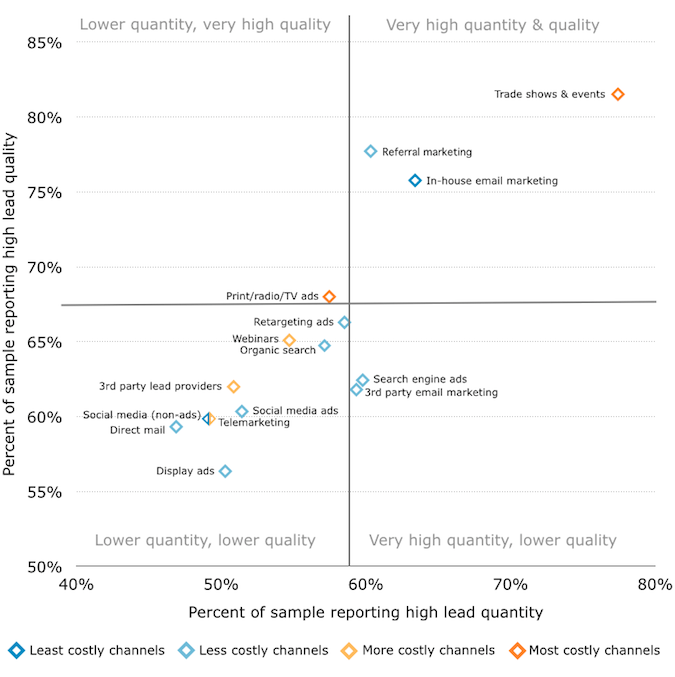 Going to trade shows and in-person events can be an expensive proposition. Flights, hotels, ground transportation, and registration fees add up fast – and that’s just for attendees. Companies creating a presence at these events have the extra costs of designing, creating, and shipping booths and signage as well. When you add in the missed office time and reduced productivity for attendees, presenters, and staff, it can start to seem like a lot of hassle for a small payoff. After all, do any of those meetings and exchanged business cards actually lead to new business?
Going to trade shows and in-person events can be an expensive proposition. Flights, hotels, ground transportation, and registration fees add up fast – and that’s just for attendees. Companies creating a presence at these events have the extra costs of designing, creating, and shipping booths and signage as well. When you add in the missed office time and reduced productivity for attendees, presenters, and staff, it can start to seem like a lot of hassle for a small payoff. After all, do any of those meetings and exchanged business cards actually lead to new business?
According to the results of a recent survey from Software Advice, the answer is a resounding yes. In their annual B2B Demand Generation Benchmark report, they surveyed 200 B2B marketing professionals in order to understand which channels, offers, content types, and technologies are driving results for their demand generation programs. As it turns out, the good old-fashioned in-person event comes out on top.
Quality, Quantity, and Cost
When B2B marketers were asked to rate the relative quantity and quality of leads generated through a range of channels, trade shows and events were cited as generating both the most leads as well as the best quality leads. In fact, 77% of marketers said they generated a “somewhat high” or “very high” quantity of leads, and 82% said they generated leads of “good” or “excellent” quality.
 According to Michele Linn, content development director at the Content Marketing Institute, this isn’t surprising at all. As she put it, “In the digital age, where so much stuff is online, there’s something exceptionally powerful about doing in-person events – if done well.”
According to Michele Linn, content development director at the Content Marketing Institute, this isn’t surprising at all. As she put it, “In the digital age, where so much stuff is online, there’s something exceptionally powerful about doing in-person events – if done well.”
However, while many marketers said trade shows produced a high volume of excellent leads, 83% of marketers also described these events as having a “somewhat high” or “very high” cost-per-lead. In fact, every other channel marketers are using had a lower cost-per-lead. And of course, that’s not too shocking, given the high cost of putting on a big production (or even a small one) at trade shows, not to mention the tons of tchotchkes used to attract people and get them to listen to you.
So, which channels are the cheapest? Social media, in-house email marketing and organic search were cited as having a “somewhat low” or “very low” cost-per-lead. However, whether expensive or affordable, the vast majority of marketers reported that they used all 15 of the demand generation channels listed.
 What About Next Year?
What About Next Year?
Clearly, marketers understand that events produce the most high-quality leads. They also realize that these leads don’t come cheap. However, it’s obvious that the ROI must be significant, because marketers plan to keep betting on events in the coming year.
When asked to break down their plans for future demand generation investment by channel, most marketers plan to spend the same or more in 2015 than they did this year on tradeshows and events:
- Nearly 10% said they’d spend “much more”
- About 25% said they’d spend “somewhat more”
- 46% indicated that they would spend the same amount
The only channels that will see more spending than trade shows and events are search engine advertising and social media marketing, (i.e., campaigns and programs outside of social media ads).
Calls to Action
The personal touch really seems to make a difference in today’s digital age. In addition to ranking marketing channels, Software Advice asked respondents to rank the demand- and lead-generation effectiveness of various types of content, offers and calls-to-action (CTAs). The best one? According to the survey respondents, live demos with sales reps are top-notch when it comes to generating “excellent” (45%) or “good” (42%) quality leads.
Like trade shows, live demos can deliver a more personalized experience, and that interactivity really resonates with customers. Because these scheduled events are put on by a real person, in real time, B2B prospects often assume that they’ll need to provide detailed contact information. And that kind of in-depth data results in higher quality leads. And since live demos usually occur near the end of the sales funnel, the prospects attending them are generally readier to buy.
Speaking of B2B marketing, Software Advice has created a handy chart called the B2B Channel Effectiveness Quadrant, which shows a wide-angle view of the relative effectiveness of B2B demand and lead generation channels. As you can see, trade shows and events deliver the highest quantity and quality of leads, with referral and in-house marketing following next.
 Clearly, events are a critical part of any B2B marketing plan. Whether you’re planning in-person events such as conferences and trade shows, or online experiences such as webinars or group chats, they can be an excellent way to reach your customers and prospects in meaningful ways. But it pays to have the right strategy in place before diving in – or increasing your investments.
Clearly, events are a critical part of any B2B marketing plan. Whether you’re planning in-person events such as conferences and trade shows, or online experiences such as webinars or group chats, they can be an excellent way to reach your customers and prospects in meaningful ways. But it pays to have the right strategy in place before diving in – or increasing your investments.
Want to learn more about what the future holds for marketers? Read the Software Advice B2B Demand Generation Benchmark survey report to see more predictions for demand generation strategy and spending in 2015.
Making Events More Valuable
If you’re ready to put the lead-generating power of in-person and online events to work for you, here are eight ways to maximize the value of webinars, tradeshows, executive meetings and more.
- Establish your event marketing goals. Whether you’re planning a webinar for 500 attendees or an executive dinner for a dozen, you need to start with a clear picture of what you’d like to accomplish at the end of the process.
- Decide how, where, and when to distribute invitations. The nature of your event, the time frame for the event, and your target audience will all play a role in the invitation process.
- Automate and manage the registration process. Most event registrations take place online – and those that don’t probably should.
- Establish your lead capture process. Event registrations and on-site activity (such as scanning business cards or badges) can be a source of robust and accurate lead data.
- Be prepared to score and prioritize the registrants from each event. It’s important to have a system in place that can evaluate leads based on key business criteria (job title, company name, industry, indicated interests) and prioritize them for follow up.
- Plan a nurturing strategy for the contacts you connect with during events. Leads generated at online or in-person live events should be nurtured with appropriate content and well-timed touches.
- Select your metrics and analyze your results: Establishing your event marketing goals in the first step makes it easier to choose useful metrics.
- Gather feedback from your attendees. Always look for new ways to gather comments, questions, and criticisms from anyone who has attended one of your events.
Read our blog 8 Ways to Maximize the Value of Online and in-Person Events to learn more, and get a step-by-step approach for using tradeshows and events to make lasting – and profitable – connections with prospects and customers.
